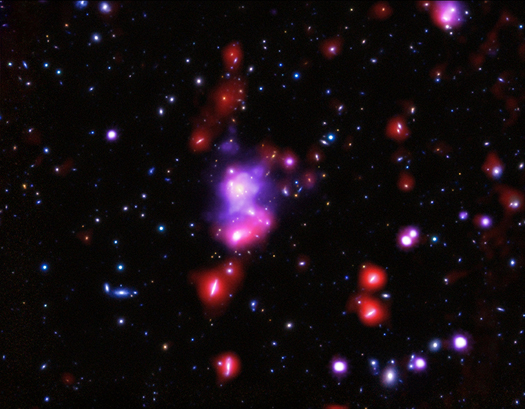For Release: December 18, 2014
CXC

Credit: X-ray: NASA/CXC/INAF/P.Tozzi, et al; Optical: NAOJ/Subaru and ESO/VLT; Infrared: ESA/Herschel
Press Image and Caption
Using NASA's Chandra X-ray Observatory, astronomers have made the first determination of the mass and other properties of a very young, distant galaxy cluster.
The Chandra study shows that the galaxy cluster, seen at the comparatively young age of about 800 million years, is the most massive known cluster with that age or younger. As the largest gravitationally- bound structures known, galaxy clusters can act as crucial gauges for how the Universe itself has evolved over time.
The galaxy cluster was originally discovered using ESA’s XMM-Newton observatory and is located about 9.6 billion light years from Earth. Astronomers used X-ray data from Chandra that, when combined with scientific models, provides an accurate weight of the cluster, which comes in at a whopping 400 trillion times the mass of the Sun. Scientists believe the cluster formed about 3.3 billion years after the Big Bang.
The cluster is officially named XDCP J0044.0-2033, but the researchers have nicknamed it “Gioiello”, which is Italian for “jewel”. They chose this name because an image of the cluster contains many sparkling colors from the hot, X-ray emitting gas and various star-forming galaxies within the cluster. Also, the research team met to discuss the Chandra data for the first time at Villa il Gioiello, a 15th century villa near the Observatory of Arcetri, which was the last residence of prominent Italian astronomer Galileo Galilei.
“Finding this enormous galaxy cluster at this early epoch means that there could be more out there,” said Paolo Tozzi of the National Institute for Astrophysics (INAF) in Florence, Italy, who led the new study. “This kind of information could have an impact on our understanding of how the large scale structure of the Universe formed and evolved.”
Previously, astronomers had found an enormous galaxy cluster, known as “El Gordo,” at a distance of 7 billion light years away and a few other large, distant clusters. According to the best current model for how the Universe evolved, there is a low chance of finding clusters as massive as the Gioiello Cluster and El Gordo. The new findings suggest that there might be problems with the theory, and are enticing astronomers to look for other distant and massive clusters.
“The hint that there might be problems with the standard model of cosmology is interesting,” said co-author James Jee of the University of California in Davis, “but we need bigger and deeper samples of clusters before we can tell if there's a real problem.”
The Chandra observation of the Gioiello Cluster lasted over 4 days and is the deepest X-ray observation yet made on a cluster beyond a distance of about 8 billion light years.
“Unlike the galaxy clusters that are close to us, this cluster still has lots of stars forming within its galaxies,” said co-author Joana Santos, also from INAF in Florence. “This gives us a unique window into what galaxy clusters are like when they are very young.”
In the past, astronomers have reported finding several galaxy cluster candidates that are located more than 9.5 billion light years away. However, some of these objects turned out to be protoclusters, that is, precursors to fully developed galaxy clusters.
The researchers also note that there are hints of uneven structure in the hot gas. These may be large clumps that could have been caused by collisions and mergers with smaller clusters of galaxies and provides clues to how the cluster became so hefty at its early age. The authors expect that the cluster is still young enough to be undergoing many such interactions.
A paper describing these results will appear in an upcoming issue of The Astrophysical Journal and is available online. NASA's Marshall Space Flight Center in Huntsville, Ala., manages the Chandra program for NASA's Science Mission Directorate in Washington. The Smithsonian Astrophysical Observatory in Cambridge, Mass., controls Chandra's science and flight operations.
An interactive image, a podcast, and a video about these findings are available at:http://chandra.si.edu
For Chandra images, multimedia and related materials, visit:
http://www.nasa.gov/chandra
Media contacts:
Janet Anderson
Marshall Space Flight Center
256-544-6162
janet.l.anderson@nasa.gov
Megan Watzke
Chandra X-ray Center, Cambridge, Mass.
617-496-7998
mwatzke@cfa.harvard.edu



Visitor Comments (4)
Yes, that is true, however think of that light as a photograph. The light has traveled 9.6 billion years, unchanged. It doesn't evolve over time. A snapshot of what it looked like when it started on its way towards Earth.
If you could instantly teleport yourself to that location it would not look the same yes. It would be 9.6 billion years older than the last photo we had seen of it.
Posted by Mercedes on Thursday, 07.23.15 @ 20:52pm
I apologize in advance if I m asking something really stupid, and I know that space time is a difficult concept to grasp for me anyway, but I have a question. If the Gioiello Cluster is 9.6 billion light years from here - Earth in my case - then how can it be 800 million years old? The light we see from the cluster must have left it 9.6 billion years ago.
Posted by Jim Brown on Sunday, 12.28.14 @ 07:57am
That's pretty young Cluster... it would be nice to know how they actually form.
Posted by budy on Friday, 12.19.14 @ 02:48am
Interesting and educational website.
Posted by Edgar Alandete on Thursday, 12.18.14 @ 13:03pm